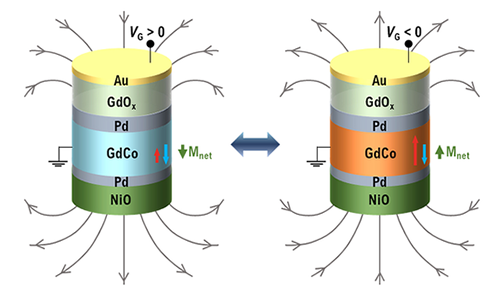| Jul 30, 2021 |
A novel route to energy saving technologies in the IT sector: Controlling ferrimagnets by voltage
(Nanowerk News) The rapid increase in energy consumption related to digital technologies is a major global challenge. One key problem is the reduction of the energy consumption of magnetic data storage devices, which are used, for example, in large data centers.
|
|
An international research team lead by the Massachusetts Institute of Technology (MIT) and with participation of Prof. Karin Leistner and Dr. Jonas Zehner from the Professorship of Electrochemical Sensors and Energy Storage at the Institute of Chemistry at Chemnitz University of Technology (previously head of the research group Magneto-ionics and Nanoelectrodeposition at the Leibniz Institute for Solid State and Materials Research (IFW) Dresden) now demonstrate 180° magnetization reversal by voltage-induced hydrogen loading into ferrimagnets.
|
|
This result is of outstanding relevance, as 180° magnetization reversal by purely electric fields is inherently difficult from fundamental principles, but it promises a drastic reduction in energy consumption for magnetization switching. For application in data storage and manipulation, 180° magnetization switching is crucial, as the magnetization in the individual bits is usually opposed by 180°. Thus, the result of the study has the potential to open a pathway to dramatically reduced global power consumption of data storage.
|
|
Besides the participants from MIT and Chemnitz University of Technology, the research team included scientists from the University of Minnesota, Korea Institute of Science and Technology and ALBA Synchrotron in Barcelona. The lead was taken by the material scientists Dr. Mantao Huang and Prof. Geoffrey Beach from MIT, experts in hydrogen-based magneto-ionic devices and spintronics.
|
 |
| Scheme of the optimized exchange-biased NiO-GdCo-layers for voltage-induced 180° net magnetization reversal. (Image: Mantao Huang, MIT)
|
|
The results were published in Nature Nanotechnology ("Voltage control of ferrimagnetic order and voltage-assisted writing of ferrimagnetic spin textures").
|
New approach
|
|
In magnetic data storage media, such as hard disc drives or MRAMs (Magnetic Random Access Memories), information is stored through a specific alignment of magnetization in microscopic areas. The direction of magnetization is usually adjusted by electric currents or local magnetic fields –these magnetic fields are also generated by electrical currents in microcoils. In both cases, the electric current leads to energy loss by Joule heating. Therefore, the control of magnetization by electric fields is a promising approach to reduce the energy consumption of magnetic data technologies. So far, however, electric field control of magnetization requires high voltages or is restricted to low temperatures.
|
|
As a new approach towards voltage-induced magnetization switching, the research team took advantage of the specific properties of ferrimagnets. Ferrimagnets offer a multi-sublattice configuration with sublattice magnetizations of different magnitudes opposing each other. The net magnetization arises from the addition of the sublattice contributions. Ferrimagnets also have technological advantages over conventionally used ferromagnets, as they allow for, for example, fast spin dynamics.
|
|
For ferrimagnetic gadolinium-cobalt (GdCo) the researchers could demonstrate that the relative sublattice magnetizations can be reversibly toggled by voltage-induced hydrogen loading/unloading. For this, the GdCo was combined with a gadolinium oxide (GdOx) layer as solid state electrolyte and a palladium (Pd) interlayer.
|
|
By applying a gate voltage across the structure, protons are driven to the bottom electrode and lead to hydrogenation of the Pd/GdCo layer. The introduction of hydrogen into the GdCo lattice leads to a stronger reduction of the sublattice magnetization of Gd than that of Co. This so-called magneto-ionic effect is stable over more than 10 000 cycles. It could be evidenced by element-specific X-ray magnetic circular dichroism (XMCD) spectroscopy and is the foundation of the demonstrated magnetization switching.
|
|
To achieve 180° magnetization reversal without external magnetic fields, the researchers functionalized the GdCo/Pd/GdOx-layer structure with an additional antiferromagnetic nickel oxide (NiO) layer. Here, they profit from the so-called “Exchange Bias” effect.
|
|
This effect occurs when ferri- or ferromagnetic layers are put in contact with an antiferromagnetic layer. It is based on the coupling of the interfacial magnetic spins and leads to the pinning of the magnetization direction of the ferro/ferrimagnet. The exchange bias effect is used, e.g., in magnetic sensors in read heads of hard disc drives to pin the magnetization direction of a reference layer.
|
|
For ferromagnetic GdCo, the contact to the antiferromagnetic NiO leads to a pinning of the direction of the sublattice magnetizations. In this case, during the magneto-ionic switching, the net magnetization switches by 180°. This signifies, for the first time, a purely electric field controlled magnetization reversal without the assistance of a magnetic field.
|
|
Prof. Karin Leistner and Dr. Jonas Zehner brought in their expertise on the transfer of magneto-ionic control to exchange bias systems. "My group intensively studies the combination of magneto-ionic systems with aniferromagnetic layers and we are by now experts in the magneto-ionic control of exchange bias," explains Prof. Karin Leistner.
|
|
During his PhD time in the research group of Karin Leistner at the IFW Dresden, Jonas Zehner took the opportunity of a 6 month research stay in the group of Prof. Beach at MIT. During this research stay, together with Prof. Karin Leistner and Prof. Geoffrey Beach, Jonas Zehner initiated and optimized the exchange-bias layer structure required for the 180° magnetization reversal. For this, he first combined the magneto-ionic model system Co/GdOx with antiferromagnetic NiO. He prepared thin film systems by magnetron sputtering and analyzed the influence of thickness, composition and layer sequence on the resulting exchange bias and magneto-ionic control.
|
|
The magnetic properties during hydrogen loading were measured with a home-built magneto-optical Kerr Effect setup. With these experiments, he discovered that an ultrathin Pd layer between the GdCo and the NiO is crucial to stabilize the exchange bias effect.
|

